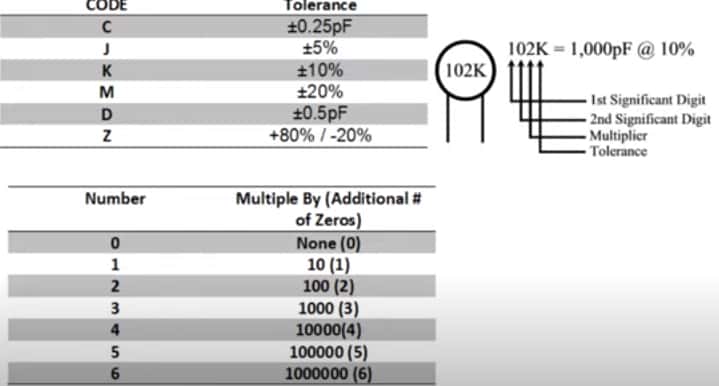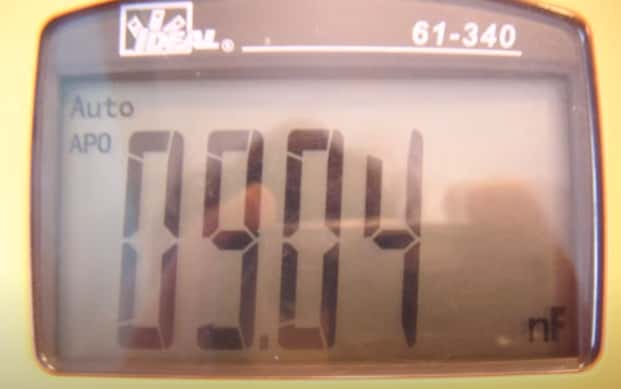There are several variations of the capacitor symbol. So today, we’re just going to be focusing on how to read ceramic capacitors. The one on the left is for electrolytic capacitors. Ceramic capacitors don’t have a polarity. It is why the schematic symbol is slightly different than the electrical added capacitor. Now there are two charts we have to reference when we’re talking about a capacitor.
| Marking | Capacitance (pF) | Capacitance (ìF) |
|---|---|---|
| 101 | 100 pF | 0.0001 ìF |
| 221 | 220 pF | 0.00022 ìF |
| 471 | 470 pF | 0.00047 ìF |
| 102 | 1,000 pF | 0.001 ìF |
| 222 | 2,200 pF | 0.0022 ìF |
| 472 | 4,700 pF | 0.0047 ìF |
| 103 | 10,000 pF | 0.01 ìF |
| 223 | 22,000 pF | 0.022 ìF |
| 473 | 47,000 pF | 0.047 ìF |
| 104 | 100,000 pF | 0.1 ìF |
| 224 | 220,000 pF | 0.22 ìF |
| 474 | 470,000 pF | 0.47 ìF |
| 105 | 1,000,000 pF | 1 ìF |
| 225 | 2,200,000 pF | 2.2 ìF |
| 475 | 4,700,000 pF | 4.7 ìF |
Letter printed capacitor indicate tolerance
| Letter | Tolerance |
|---|---|
| A | ±0.05 pF |
| B | ±0.1 pF |
| C | ±0.25 pF |
| D | ±0.5 pF |
| E | ±0.5% |
| F | ±1% |
| G | ±2% |
| H | ±3% |
| J | ±5 % |
| K | ±10% |
| L | ±15% |
| M | ±20% |
| N | ±30% |
| P | –0%, + 100% |
| S | –20%, + 50% |
| W | –0%, + 200% |
| X | –20%, + 40% |
| Z | –20%, + 80% |
What is a ceramic capacitor?

What is a ceramic capacitor? The ceramic capacitor looks like a disc shape, and it is minimal. The ceramic capacitor has two terminals. It is a non-polarized capacitor, which means there’s no difference between the positive and negative terminal. Look here inside the ceramic capacitor. The outer court protects the inner side of the capacitors. This one is the electrode, and the upper one is the dielectric ceramic disc.
Therefore, called a ceramic capacitor. This ceramic disc stores the charges. It is the symbol of the ceramic capacitor. The small disc and the small dot represent the ceramic capacitor. The range of ceramic capacitors is from 0 to 0.01 microfarad to 1 fraud.
Where to use a ceramic capacitor?
The ceramic capacitor is used in various places. Mainly it’s used for filtration. It’s used in a signal or frequency circuit to filter the signal to pure the signal. It’s also used on a DC to a pure DC. The ceramic capacitor is used to store energy. It is storing the DC but passing the AC. It is what the ceramic capacitor is.
How we read ceramic capacitor value

The first one is an alphabetic code, which tells us the tolerance of the component. The second one is numeric code, which tells us the actual size of the capacitance of the capacitor.
So we’re going to be looking at our example right now. And our example says 102 k. If we break down the code, the first significant digit is one, and the second significant digit is zero. So these are numbers in front of our multiplier.
Calculate ceramic capacitor value
So now, when we take your multiplier, which is two, and when we look on the chart, that means two zeros. So we add two zeros to the end of the number. So it’s 1000, picofarad. Now, K represents our tolerance of the component, which in this case is plus or minus 10%. So that’s how we determine the size and the rating of the capacitor.
Check here how to measure a capacitance of a capacitor by hooking it up to a multimeter. So in this example, I’m using a capacitor with a numerical value written on it of 103, which works out to be 10-nanofarads.

Now when you look at the display of what is rated, its practical rating is it works it’s nine ferrites. So tolerances about 10%. Now, when you’re connecting it to your basic multimeter. Make sure you have an appropriate terminal in this one. As you can see in the bottom right-hand corner, I have the capacitance symbol. Then make sure you’re in the appropriate range of your multimeter. And then to make sure you select the appropriate setting.
Ceramic disk capacitor codes table
| Picofarad pF | Nanofarad nF | Microfarad µF | Code |
|---|---|---|---|
| 10 | 0.01 | 0.00001 | 100 |
| 15 | 0.015 | 0.000015 | 150 |
| 22 | 0.022 | 0.000022 | 220 |
| 33 | 0.033 | 0.000033 | 330 |
| 47 | 0.047 | 0.000047 | 470 |
| 100 | 0.1 | 0.0001 | 101 |
| 120 | 0.12 | 0.00012 | 121 |
| 130 | 0.13 | 0.00013 | 131 |
| 150 | 0.15 | 0.00015 | 151 |
| 180 | 0.18 | 0.00018 | 181 |
| 220 | 0.22 | 0.00022 | 221 |
| 330 | 0.33 | 0.00033 | 331 |
| 470 | 0.47 | 0.00047 | 471 |
| 560 | 0.56 | 0.00056 | 561 |
| 680 | 0.68 | 0.00068 | 681 |
| 750 | 0.75 | 0.00075 | 751 |
| 820 | 0.82 | 0.00082 | 821 |
| 1000 | 1.0 | 0.001 | 102 |
| 1500 | 1.5 | 0.0015 | 152 |
| 2000 | 2.0 | 0.002 | 202 |
| 2200 | 2.2 | 0.0022 | 222 |
| 3300 | 3.3 | 0.0033 | 332 |
| 4700 | 4.7 | 0.0047 | 472 |
| 5000 | 5.0 | 0.005 | 502 |
| 5600 | 5.6 | 0.0056 | 562 |
| 10000 | 10 | 0.1 | 102 |
| 15000 | 15 | 0.015 | 152 |
| 22000 | 22 | 0.022 | 223 |
| 33000 | 33 | 0.033 | 333 |
| 47000 | 47 | 0.047 | 473 |
| 68000 | 68 | 0.068 | 683 |
| 100000 | 100 | 0.1 | 104 |
| 150000 | 150 | 0.15 | 154 |
| 200000 | 200 | 0.2 | 254 |
| 220000 | 220 | 0.22 | 224 |
| 330000 | 330 | 0.33 | 334 |
| 470000 | 470 | 0.47 | 474 |
| 680000 | 680 | 0.68 | 684 |
| 1000000 | 1000 | 1.0 | 105 |
| 1500000 | 1500 | 1.5 | 154 |
| 2000000 | 2000 | 2.0 | 205 |
| 2200000 | 2200 | 2.2 | 225 |
| 3300000 | 3300 | 3.3 | 335 |
| 4700000 | 4700 | 4.7 | 475 |
The last number written on a ceramic capacitor is the power of 10 and multiplied with the first two no.
Suppose a ceramic capacitor has written 682 code; at first, check the last number. So as we can see, here is the last number is 2. Now the multiplier is 102
Some examples
- 204 = 20×104 = 200000 PF
- 472 = 47×102 = 4700 PF
- 502 = 50×102 = 5000 PF
- 330 = 33×100 = 33 PF [100 = 1]
UNITS
- 1000 nanofarad(nF) = 1 microfarad(µF)
- 1 picofarad = 10-12farads.
- Nano= 10-9
- Micro= 10-6
- 1 Nano Farad= 10-9 Farad
- 1 Microfarad (µF)= 10-6 Farad
1 nF = 1000 pF
1 pF = 0.001 nF
Example:
convert 15 nF to pF:
15 nF = 15 × 1000 pF = 15000 pF
Capacitor voltage code
| 0G | 4VDC | 0L | 5.5VDC | 0J | 6.3VDC |
| 1A | 10VDC | 1C | 16VDC | 1E | 25VDC |
| 1H | 50VDC | 1J | 63VDC | 1K | 80VDC |
| 2A | 100VDC | 2Q | 110VDC | 2B | 125VDC |
| 2C | 160VDC | 2Z | 180VDC | 2D | 200VDC |
| 2P | 220VDC | 2E | 250VDC | 2F | 315VDC |
| 2V | 350VDC | 2G | 400VDC | 2W | 450VDC |
| 2H | 500VDC | 2J | 630VDC | 3A | 1000VDC |
Excellent site you have here but I was curious if you knew of any forums that cover the same topics discussed here? I’d really love to be a part of community where I can get suggestions from other experienced individuals that share the same interest.